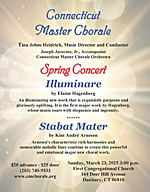Illuminare
by Elaine Hagenberg
~ plus ~
Stabat Mater
by Kim André Arnesen
Spring 2025 Concert Notes
Tina Johns Heidrich, Conductor
Joseph Jacovino, Jr., Accompanist
Connecticut Master Chorale Orchestra
Sunday March 23, 2025 - 3:00 pm
First Congregational Church, Danbury, Connecticut
- Concert Photos - Concert Recording -
Illuminare – Elaine Hagenberg

Elaine Hagenberg
b. 1979
Illuminare is Elaine Hagenberg's first extended work. Using lesser-known sacred Latin texts, the five movements create a narrative arc.
Movement one (Splendor) opens with majesty and brightness, representing the entrance of Light, and voices enter with a hymn text attributed to St. Ambrose in a joyful "Gloriae" section. A portion of the peace theme is revealed with the cellos and will emerge again throughout the work.
Movement two (Caritas) features women's voices at the onset and portrays a tender season of beauty. The elegant words of Hildegard von Bingen take us takes us back to an image of Eden, a time of goodness and purity. A brief moment of the peace theme reappears in the cello.
Movement three (Nox) makes a dramatic shift, sensing an ominous shadow on the horizon. The choir sings the traditional Greek Kyrie text (Lord have mercy). A blast of fury disrupts the world as the text turns to Nox et Tennebrae (night and darkness), with chaos, confusion and despair.
In movement four (Munera pacis), the darkness fades away with the words of St. Gregory (grant us peace). The music becomes still and calm and the cello peace theme is revealed to be the voice of Christ assuring us: "Peace I leave with you, my peace I give to you". The orchestra concludes by echoing the beauty of movement two, now with a new hope of an even greater peace.
Movement five (Illuminare his) reveals that joy is restored, and the choir sings from the prophesy in the Canticle of Zechariah: "illuminare his qui in tenebris" (illuminate those in darkness). Light has triumphed to guide us toward a brighter future.
Elaine Hagenberg is one of today's leading choral composers, with music that "soars with eloquence and ingenuity". Educated at Drake University, she offers a unique blend of artistic sophistication and universal appeal, creating music that resonates with conductors, performers and audiences alike. Her work has been performed at Carnegie Hall, the Vatican, St. Patrick's Cathedral in Dublin, St. Mark's Basilica in Rome, and other venues around the world.
Her compositional style is profoundly influenced by her connection to nature, beauty, and spiritual reflection. Drawing inspiration from the vivid imagery and themes found in poetry, she crafts intricate musical textures that enrich her narratives. In addition to composing full time, she is a sought-after guest artist and clinician, known for fostering meaningful connections through music.
When she is not composing, Elaine enjoys spending time with her family and watching her four children pursue their passions.
Stabat Mater – Kim André Arnesen

Kim André Arnesen
b. 1980
Kim André Arnesen's Stabat Mater breathes new life into the 13th century hymn, which portrays the Virgin Mary's suffering at the crucifixion of her son, Jesus Christ. Arnesen's characteristic rich harmonies and memorable melodic lines combine to create a powerful and emotional major new work.
Notes from Kim André Arnesen:
"In my Magnificat (2010), we met the Virgin Mary in a moment of joy and wonder as she received the news that she would become the mother of the Son of God. In Stabat Mater, we meet her in deepest sorrow, witnessing the crucifixion of her son, Jesus Christ.
"Mary, the mother of Jesus, gave life to God. Throughout history, her image has been depicted in various ways: sometimes, we see her in joy as she comforts her child tenderly in her lap, and at other times, we see her in grief, weeping at the foot of the cross. Like Mary, some parents' lives consist of overwhelming joy and immense sorrow. No joy compares to creating life, and no pain compares to seeing that life taken too soon."
One of the most frequently performed contemporary composers, Kim André Arnesen is a classical composer from Trondheim, Norway. At the age of ten, he was a huge fan of MTV, but he also studied classical piano, sang in the Nidaros Cathedral Boys Choir, and was educated at the Musical Conservatory in Trondheim. With deep interests in baroque, contemporary classical, and popular music, his musical career could have ventured down many paths, but choral music became his greatest passion.
The first performance of his work occurred when he was only 18, and his first major work, Magnificat, was recorded and received rave reviews from prominent classical music magazines, and was nominated for a Grammy. Success has followed with many other notable works and Grammy nominations. Today, his music has been performed in more than 50 countries, and he has also released his first piano music on Decca Classics, with one of the singles reaching number 1 on Apple Music's classical charts.
His recent collaborations include the BBC Singers, as well as the world-renowned violinist and Hardanger fiddle player Ragnhild Hemsing.



